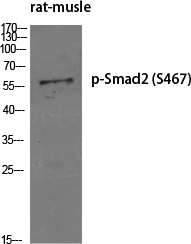Phospho Smad2 (T220) Cell-Based Colorimetric ELISA Kit
- 货号:KA1138C
- 应用:ELISA
- 种属:Human;Mouse;Rat
- 基因名称:
- SMAD2
- Human Gene Id:
- 4087
- Human Swiss Prot No:
- Q15796
- Mouse Swiss Prot No:
- Q62432
- Rat Swiss Prot No:
- O70436
- 储存:
- 2-8°C/6 months
- 其他名称:
- Mothers against decapentaplegic homolog 2 (MAD homolog 2) (Mothers against DPP homolog 2) (JV18-1) (Mad-related protein 2) (hMAD-2) (SMAD family member 2) (SMAD 2) (Smad2) (hSMAD2)
- 检测方法:
- Colorimetric
- 功能:
- embryonic axis specification, in utero embryonic development, formation of primary germ layer, mesoderm formation,peptide secretion, generation of a signal involved in cell-cell signaling, regionalization, transcription, regulation of transcription, DNA-dependent, regulation of transcription from RNA polymerase II promoter, RNA processing, protein complex assembly, protein amino acid phosphorylation, phosphorus metabolic process, phosphate metabolic process,cell surface receptor linked signal transduction, enzyme linked receptor protein signaling pathway, transmembrane receptor protein serine/threonine kinase signaling pathway, transforming growth factor beta receptor signaling pathway, SMAD protein complex assembly, intracellular signaling cascade, cell-cell signaling, zygotic determination of dorsal/ventral axis, gastrulation, pattern specification process, mesoderm development, heart
- 细胞定位:
- Cytoplasm . Nucleus . Cytoplasmic and nuclear in the absence of TGF-beta. On TGF-beta stimulation, migrates to the nucleus when complexed with SMAD4 (PubMed:9865696, PubMed:21145499). On dephosphorylation by phosphatase PPM1A, released from the SMAD2/SMAD4 complex, and exported out of the nucleus by interaction with RANBP1 (PubMed:16751101, PubMed:19289081). Localized mainly to the nucleus in the early stages of embryo development with expression becoming evident in the cytoplasm at the blastocyst and epiblast stages (By similarity). .
- 组织表达:
- Expressed at high levels in skeletal muscle, endothelial cells, heart and placenta.
- June 19-2018
- WESTERN IMMUNOBLOTTING PROTOCOL
- June 19-2018
- IMMUNOHISTOCHEMISTRY-PARAFFIN PROTOCOL
- June 19-2018
- IMMUNOFLUORESCENCE PROTOCOL
- September 08-2020
- FLOW-CYTOMEYRT-PROTOCOL
- May 20-2022
- Cell-Based ELISA│解您多样本WB检测之困扰
- July 13-2018
- CELL-BASED-ELISA-PROTOCOL-FOR-ACETYL-PROTEIN
- July 13-2018
- CELL-BASED-ELISA-PROTOCOL-FOR-PHOSPHO-PROTEIN
- July 13-2018
- Antibody-FAQs

